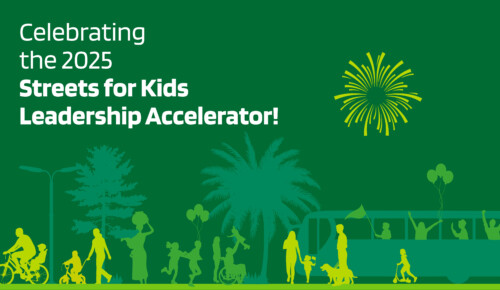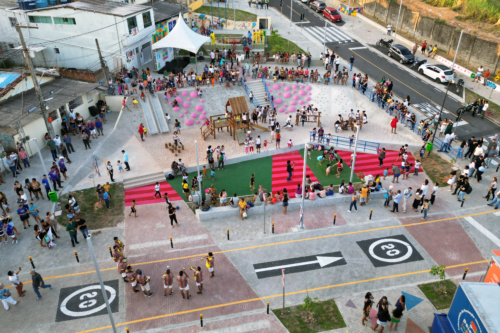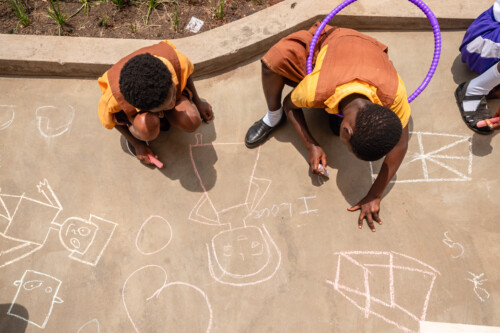Two mirrors, one large sheet of cardboard, a ruler, knife, and some tape. That’s all it takes to create a Streets for Kids Reverse Periscope — a simple DIY tool that can help adults experience streets from a child’s height.
In February, GDCI’s Streets for Kids program released How Do Kids Experience Streets? The Reverse Periscope Companion Guide to help everyone create and use a Reverse Periscope. The guide offers step-by-step instructions for building a Reverse Periscope, and includes an interactive dimensions generator, downloadable Streets for Kids stickers, and a wrap. The companion guide goes beyond helping you make a Reverse Periscope and also includes guidance for how to use it. The guide includes suggested agendas and checklists for a workshop as well as activity cards to conduct a “walkshop” to evaluate your streets from the perspective of children. Detailed case studies offer additional insights and inspiration for first-time users.
On Wednesday, March 9, 2023, the Streets for Kids team hosted a webinar all about the Reverse Periscope and how to use it. The recording of the webinar is now available, along with a brief video tutorial for constructing the reverse periscope.
During this hour-long discussion, the Streets for Kids team delved into the resources available to create and build a reverse periscope. GDCI staff opened with an overview of the need to design streets with children’s perspectives in mind and reviewed the resources available to build and use the reverse periscope. Then, they were joined by Lina Quiñones of Despacio, a Bogotá-based NGO working to improve the quality of life for people of different ages in cities, and Andrea Loyola, the co-founder, and director of operations at the Lima-based ANIDARE organization that combines architecture and education to focus on people and early childhood. Both guest speakers shared their experiences using the reverse pericope in their city streets.
Assembling their Periscope and taking it out on a walk, this was the first time Despacio staff members saw their familiar streets from the eye level of young children. This new perspective, at the height of car tires, made cars seem “as scary as monster trucks,” while bike racks and other mundane street elements now seemed intriguing and playful. Lina and her colleagues especially noted the virtue of having an easy-to-build and affordable tool that could immediately be taken into real streets in their community, unlike expensive alternatives such as virtual reality devices or other computer-generated scenes. The fact that the periscope is fun and immersive, she noted, made it an engaging way to capture stakeholders’ attention and demonstrate children’s experiences on their streets.
Andrea shared her insights about using the reverse periscope in an educational capacity. She partnered with the City of Lima to produce a workshop and a walkshop for a group of civil engineering students who may one day become transportation planners in charge of street design. As the engineering students walked the streets in groups, they took turns alternating the roles as themselves, as children, and as caregivers escorting a “child” using the periscope. For some, she explained, using the Reverse Periscope was the first time they considered their immense responsibility as engineers to design safer, more comfortable, and more enjoyable streets for children and caretakers in their city. This experience, she said, will stay in their hearts.
The webinar concluded with a brief Q&A session. Among others, the panelists discussed ways to attract the attention of the mainstream media to address the issues and help raise public awareness of children’s needs as users of the streets.
Below you can find extended answers to questions that attendees raised but were not addressed in full during the webinar:
Do you have any references for the data from other projects around the world? Do you have examples of transformations that improved cities for all ages and not just for children?
At the Streets for Kids program, we believe that streets that work better for children and caregivers work better for everyone. However, GDCI works through different programs to bring a focus on kids, road safety, and bicycle infrastructure, as well as to create streets that put people first. To read more detailed case studies of GDCI’s street transformation, visit our Resources page.
Some cities in the world, especially in low-income countries, suffer from a lack of basic street infrastructure, resulting in dangerous street conditions for kids. How can we convince leaders and authorities to improve their policies?
Improving basic street infrastructure in low-income countries is a complex issue that requires the cooperation of various stakeholders, including community members, NGOs, local authorities, and government officials. Here are some strategies that can help convince leaders and authorities to improve their policies:
- Highlight the Importance of Safe Streets for Children: Leaders and authorities need to understand the importance of safe streets for children and how it can contribute to their overall well-being. You can share statistics and research findings that show how dangerous street conditions can affect the physical and mental health of children.
- Involve the Community: Involve the local community, especially parents and teachers, in advocating for better street infrastructure. This can include organizing community meetings, rallies, and other events to raise awareness and demand action.
- Engage with Local Authorities: Work with local authorities and government officials to identify the main issues and potential solutions. This can involve presenting proposals for new infrastructure, such as sidewalks, pedestrian crossings, and traffic signals, as well as advocating for improved road maintenance and traffic enforcement.
- Partner with NGOs and International Organizations: NGOs and international organizations can provide valuable support and resources, including technical assistance, funding, and expertise in advocacy and policy development. Partnering with these organizations can help amplify your message and increase your impact.
- Utilize Social Media and Technology: Use social media and technology to raise awareness and mobilize support. You can create a social media campaign, share videos and images that highlight the issues, and use online petitions to collect signatures and demonstrate community support.
Ultimately, the key to convincing leaders and authorities to improve their policies is to build a broad-based coalition of stakeholders who are committed to making their communities safer for children. By working together and leveraging the power of advocacy and technology, you can make a real difference and improve the lives of children in low-income countries.
Will you host an additional session aimed at decision-makers? Has anyone ever produced a workshop for middle/high school children to build and use the reverse periscope?
Streets for Kids produced the Reverse Periscope companion guide and the webinar to make building and using the pericope in your city easy and affordable. We invite everyone to adapt the suggested agenda, checklists, and activity cards detailed in the companion guide to producing workshops and walkshops to fit your city’s needs, including advocacy and education.
Resources shared during the event:
Finally, we’re always excited to see how people are using our tools, so if you build a Reverse Periscope and use it in your community, please tag us at @GlobalStreets on Twitter or @global.streets on Instagram and use the hashtag #StreetsForKids. We look forward to seeing how it transforms your understanding of Streets for Kids.




